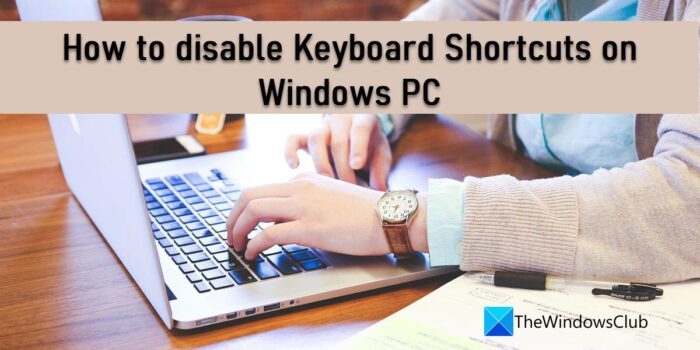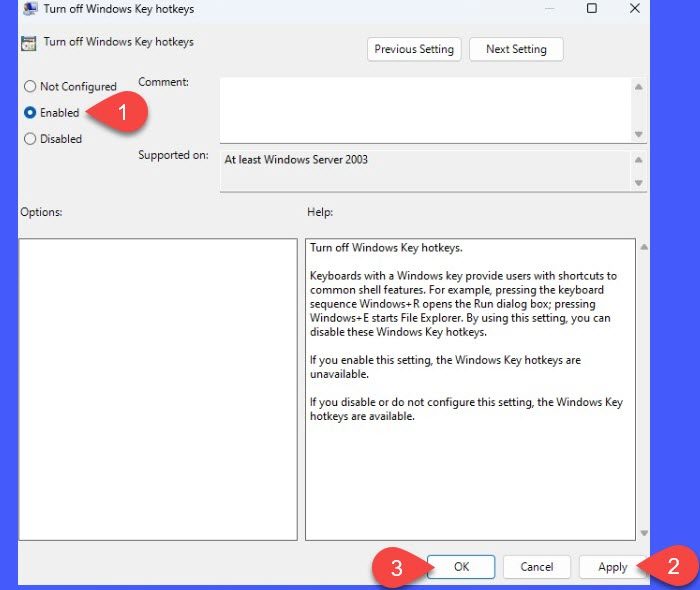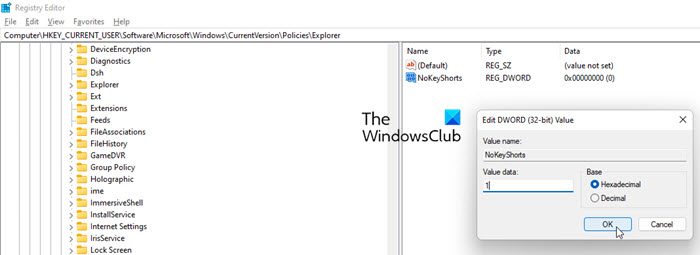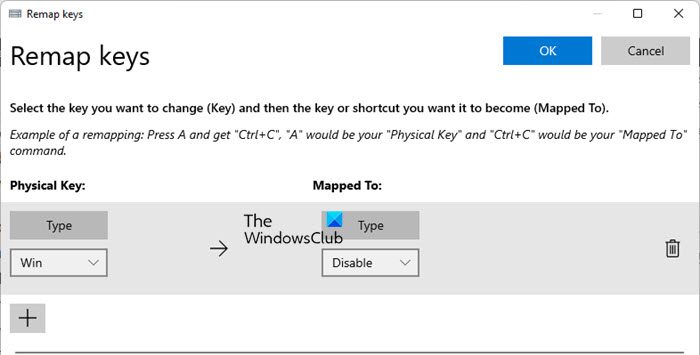This post explains how to disable keyboard shortcuts on Windows 11/10 PC. Windows offers some built-in shortcut keys (or hotkeys) that are intended to help users quickly launch apps or perform other tasks without using the mouse. For example, the Windows logo key launches the Start menu on Windows 11/10. Similarly, the Esc key aborts or closes the current task.

These hotkeys can sometimes create issues when accidentally pressed by other people, such as small kids at home. A few Windows users have also reported that the hotkeys are troubling them when they play games in full-screen mode. For example, the Windows logo key, which is located near the Shift key (universal key for running) and the Ctrl key (fires a weapon in gaming), causes them to jump out of the game all of a sudden when pressed accidentally. Likewise, the Shift key opens the Sticky Keys prompt when pressed accidentally multiple times.
How to disable Keyboard Shortcuts on Windows 11/10
If Windows hotkeys are somehow bothering you or ruining your PC gaming experience, then you have the option to disable them temporarily. To disable keyboard shortcuts on Windows 11/10, use the following solutions:
- Disable keyboard shortcuts using Local Group Policy Editor
- Disable keyboard shortcuts using Registry Editor
- Disable keyboard shortcuts using Microsoft PowerToys
Let us look at each of these solutions in detail.
1] Disable keyboard shortcuts using Local Group Policy Editor

Microsoft’s Group Policy Editor is an administrative tool that allows you to configure policies and override default settings on your Windows 11/ 10 PC. Here’s how you can use it to disable hotkeys on Windows:
-
- Press the Win+R key combination on your keyboard.
- In the Run dialogue box that appears, type gpedit.msc.
- Press the Enter key.
- Select Yes in the User Account Control prompt.
- In the Group Policy Editor window, navigate to the following path:
User Configuration > Administrative Templates > Windows Components > File Explorer
- Navigate to Turn off Windows Key hotkeys policy on the right panel.
- Double-click on it and select Enabled in the Policy Settings window.
- Click on the Apply button.
- Then click on OK.
- Exit the Group Policy Editor and reboot your Windows 11/ 10 PC.
Note:
- You will not be able to access the Group Policy Editor if you have the ‘Home’ edition of Windows. In that case, you may either install the Group Policy Editor via this workaround or move to the next solution in the queue.
- To enable the Windows hotkeys back, you may navigate to the same path in the Group Policy Editor and turn the policy setting to ‘Disabled’.
2] Disable keyboard shortcuts using Registry Editor

Windows Registry Editor allows you to view or edit keys in the Windows registry database. This database consists of settings required by the Operating System to function properly. Here’s how you may use the Registry Editor to disable keyboard shortcuts on Windows:
- Click on the taskbar search icon.
- Type ‘regedit‘. Registry Editor will appear on top of the search results.
- Click on Run as administrator on the right panel.
- In the Registry Editor window, navigate to the following path:
HKEY_CURRENT_USER > Software > Microsoft > Windows > CurrentVersion > Policies
- Right-click anywhere in the empty space on the right panel.
- Select New > Key and name the key as ‘Explorer‘.
- No again right-click anywhere on the right panel and select New > DWORD (32-bit) Value.
- Name it as NoKeyShorts.
- Double-click on NoKeyShorts and set its value to 1.
- Click on the OK button.
- Exit the Registry Editor and Reboot your PC.
This should disable all your Windows keyboard shortcuts. To re-enable them, simply delete the NoKeyShorts key you’ve created following the steps mentioned above.
Tip: Create a system restore point before tweaking the Windows registry or changing the Group Policy settings. A slight error while working with these applications might lead you to a problematic situation.
Also Read: Windows Registry Editor Tips & Features.
3] Disable keyboard shortcuts using Microsoft PowerToys

Microsoft PowerToys is an open-source Windows utility software that allows users to enhance their Windows experience through a set of applications including (but not limited to) Color Picker, Image Resizer, and Keyboard Manager. The Keyboard Manager allows you to remap shortcuts on Windows. Let’s see how to use it to temporarily disable the Windows logo key or any other key on your keyboard.
- Download and Install PowerToys.
- Launch the PowerToys app.
- Select Keyboard Manager from the options available on the left.
- Click on the Open Settings button on the right panel.
- Click on Remap a key option under the heading ‘Keys’.
- In the Remap Keys window that appears, click on the + icon.
- Choose Win in the ‘Physical Key’ dropdown.
- Choose Disable in the ‘Mapped To’ dropdown.
- Click on the OK button on top.
- Click on Continue Anyway in the confirmation prompt that appears.
This will immediately disable your Windows logo key, without having you reboot the PC. When the Win key is disabled, all its associated keyboard shortcuts will stop working. Similarly, you can temporarily disable other keys. When you wish to re-enable the keys, simply click on the Delete (bin) icon next to the mapping in the PowerToys app.
How do I turn off keyboard shortcuts in Windows 11?
You may turn off your keyboard shortcuts in multiple ways. The easiest way is to use the Microsoft PowerToys application. This application allows you to disable certain keys, such as the Windows logo key or the Esc key. You can temporarily disable keys to turn off the keyboard shortcuts associated with them. Other methods include using the Local Group Policy Editor and the Windows Registry Editor. Refer to the above post to know how to use these methods to turn off keyboard shortcuts on Windows 11/ 10 PC.
How do I manage keyboard shortcuts in Windows 11?
Although there is no in-built tool to manage keyboard shortcuts in Windows 11, you can use the PowerToys to get the job done. It comes with several options that allow you to manage hotkeys. Whether you want to modify a preset shortcut or custom shortcut, you can manage them both using this app.
Read Next: Keyboard shortcuts and Hotkeys are not working in Windows 11/10.
Leave a Reply